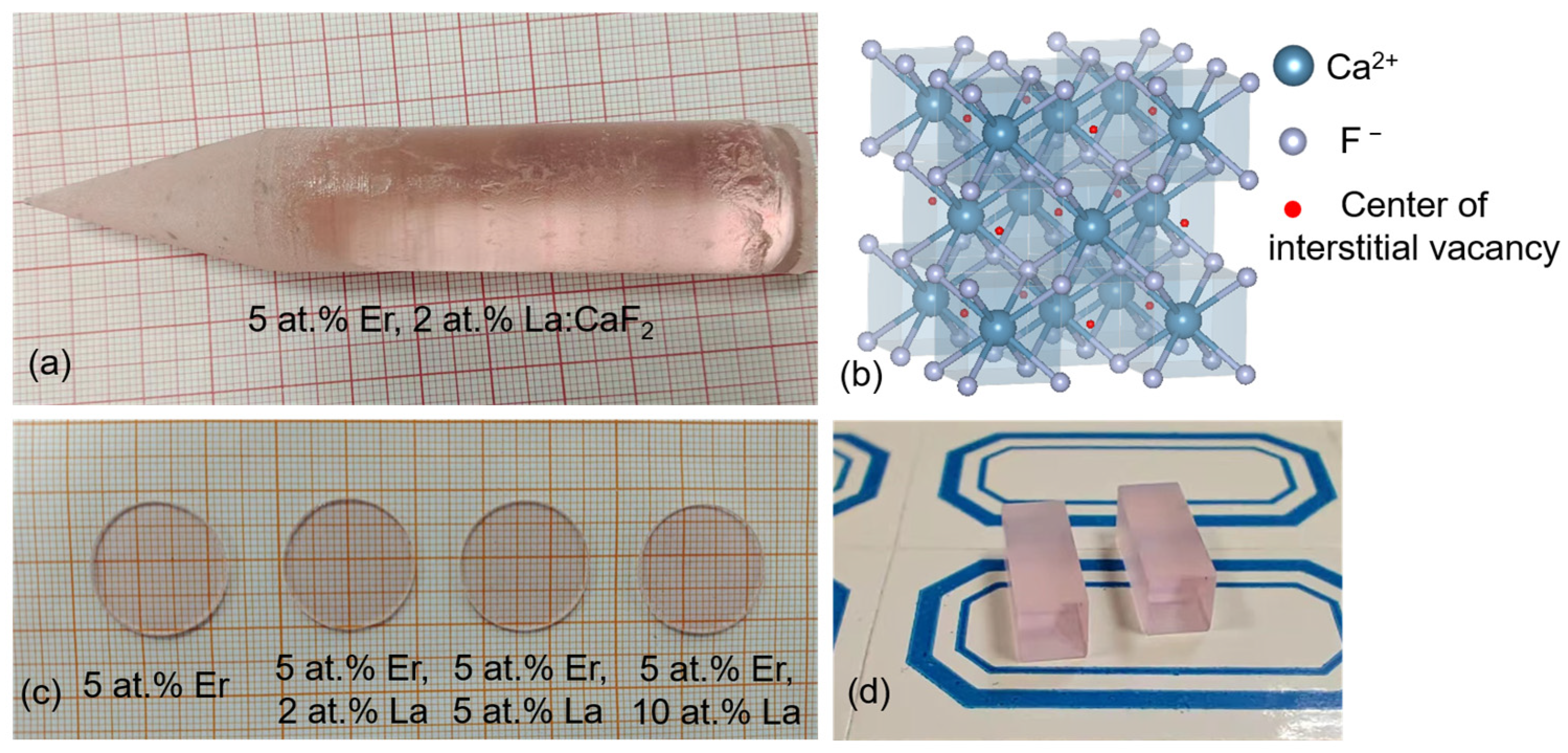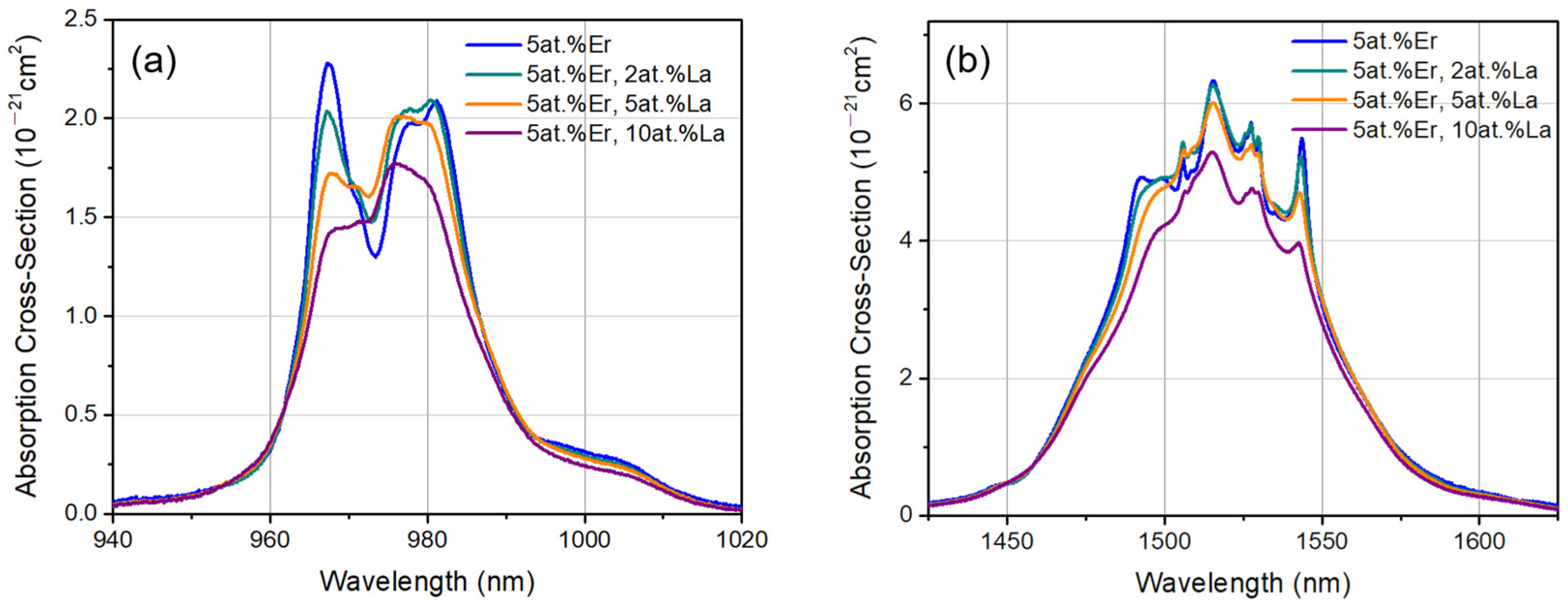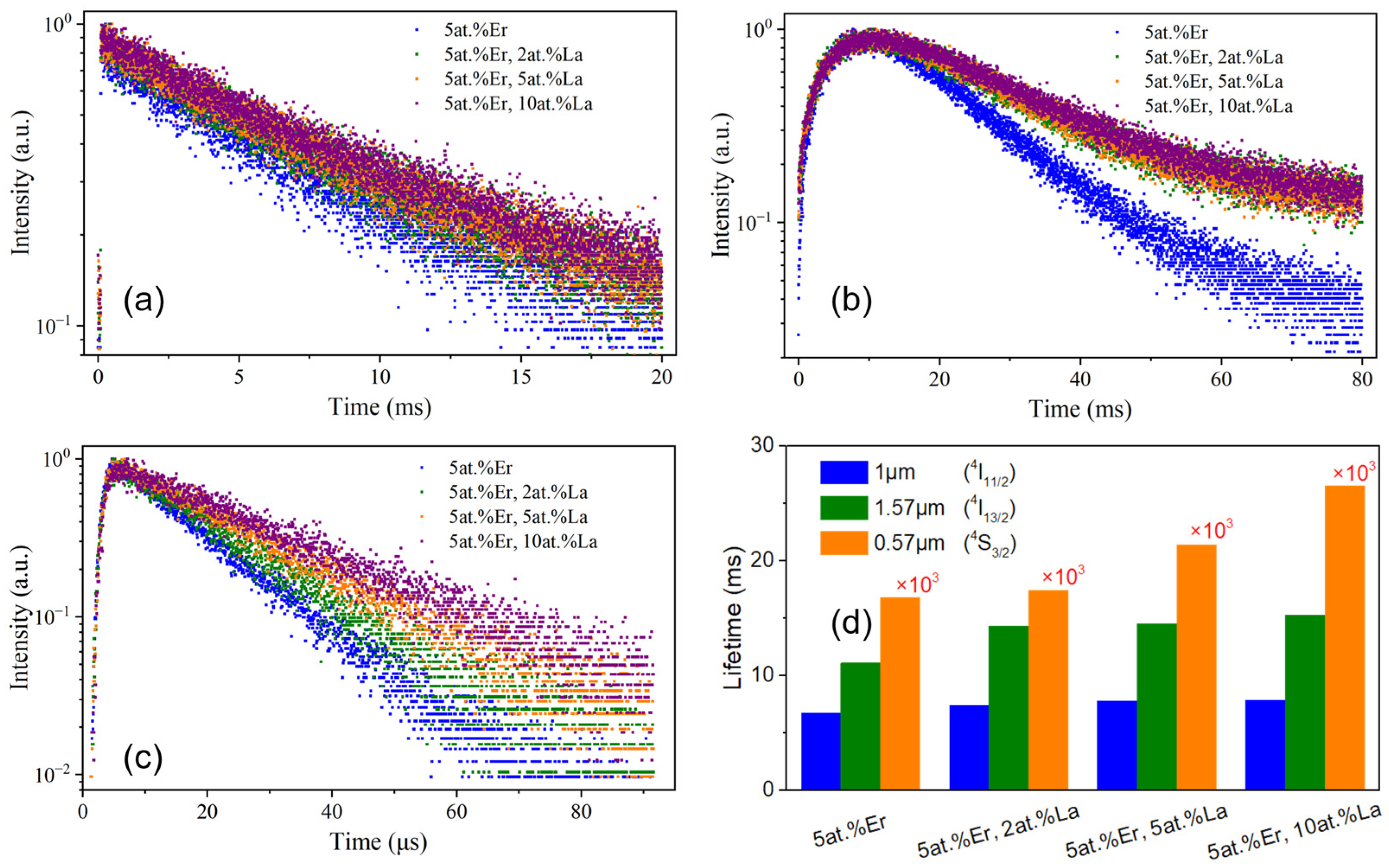Study on Spectral Properties and Mid-Infrared Laser Performance of Er, La:CaF2 Crystals
Abstract
1. Introduction
2. Materials and Methods
3. Results and Discussion
4. Conclusions
Author Contributions
Funding
Data Availability Statement
Acknowledgments
Conflicts of Interest
References
- Kaufmann, R.; Beier, C. Laser skin ablation: An update on aesthetic and medical indications. Med. Laser Appl. 2004, 19, 212–222. [Google Scholar] [CrossRef]
- Parker, S. Surgical lasers and hard dental tissue. Br. Dent. J. 2007, 202, 445–454. [Google Scholar] [CrossRef]
- Walsh, B.M.; Lee, H.R.; Barnes, N.P. Mid infrared lasers for remote sensing applications. J. Lumin. 2016, 169, 400–405. [Google Scholar] [CrossRef]
- Myoung, N.; Martyshkin, D.V.; Fedorov, V.V.; Mirov, S.B. Energy scaling of 4.3 μm room temperature Fe:ZnSe laser. Opt. Lett. 2011, 36, 94–96. [Google Scholar] [CrossRef]
- Do, B.; Skolnik, L.; Skolnik, J.; Nguyen, T. Challenges in designing and building a high energy, pulsed diode-pumped MWIR Fe:ZnSe laser. In Proceedings of the Solid State Lasers XXXII: Technology and Devices, San Francisco, CA, USA, 31 January–1 February 2023; SPIE: Bellingham, WA, USA, 2023; Volume 12399, pp. 57–68. [Google Scholar]
- Zharikov, E.V.; Zhekov, V.I.; Kulevskii, L.A.; Murina, T.M.; Osiko, V.V.; Prokhorov, A.M.; Savel, A.D.; Smirnov, V.V.; Starikov, B.P.; Timoshechkin, M.I. Stimulated emission from Er3+ ions in yttrium aluminum garnet crystals at λ = 2.94 μ. Sov. J. Quantum Electron. 1975, 4, 1039. [Google Scholar] [CrossRef]
- Bagdasarov, K.S.; Zhekov, V.I.; Lobachev, V.A.; Murina, T.M.; Prokhorov, A.M. Steady-State Emission from a Y3Al5O12: Er3+ Laser (λ = 2.94 μ, T = 300 K). Sov. J. Quantum Electron. 1983, 13, 262. [Google Scholar] [CrossRef]
- Stoneman, R.C.; Lynn, J.G.; Esterowitz, L. Laser-pumped 2.8-µm Er3+:GSGG laser. In Proceedings of the Conference on Lasers and Electro-Optics, San Diego, CA, USA, 9–13 December 1991; Optical Society of America: Washington, DC, USA, 1991; p. CTuO6. [Google Scholar]
- Popov, P.A.; Fedorov, P.P.; Osiko, V.V. Thermal conductivity of single crystals with a fluorite structure: Cadmium fluoride. Phys. Solid State 2010, 52, 504–508. [Google Scholar] [CrossRef]
- Popov, P.A.; Fedorov, P.P.; Osiko, V.V. Thermal conductivity of single crystals of the Ca1−xYxF2+x solid solution. In Doklady Physics; Pleiades Publishing: Warrensburg, MI, USA, 2014; Volume 59. [Google Scholar]
- Pollnau, M. Analysis of heat generation and thermal lensing in erbium 3-μm lasers. IEEE J. Quantum Electron. 2003, 39, 350–357. [Google Scholar] [CrossRef]
- Dergachev, A.; Moulton, P.F. Tunable CW Er:YLF diode-pumped laser. In Proceedings of the Advanced Solid-State Photonics, San Antonio, TX, USA, 2–5 February 2003; Optical Society of America: Washington, DC, USA, 2003; p. 3. [Google Scholar]
- Orlovskii, Y.V.; Basiev, T.T.; Osiko, V.V.; Gross, H.; Heber, J. Fluorescence line narrowing (FLN) and site-selective fluorescence decay of Nd3+ centers in CaF2. J. Lumin. 1999, 82, 251–258. [Google Scholar] [CrossRef]
- Fan, M.; Li, T.; Zhao, J.; Zhao, S.; Li, G.; Yang, K.; Su, L.; Ma, H.; Kränkel, C. Continuous wave and ReS2 passively Q-switched Er:SrF2 laser at ~3 μm. Opt. Lett. 2018, 43, 1726–1729. [Google Scholar] [CrossRef]
- Liu, J.; Feng, X.; Fan, X.; Zhang, Z.; Zhang, B.; Liu, J.; Su, L. Efficient continuous-wave and passive Q-switched mode-locked Er3+:CaF2–SrF2 lasers in the mid-infrared region. Opt. Lett. 2018, 43, 2418–2421. [Google Scholar] [CrossRef] [PubMed]
- Liu, J.; Feng, X.; Fan, X.; Zhang, Z.; Zhang, B.; Liu, J.; Su, L. Revisiting the self-termination effect of erbium based near 3 μm mid-infrared lasers. J. Lumin. 2022, 252, 119339. [Google Scholar]
- Yang, Z.; Zhang, Z.; Zhao, Z.; Su, L.; Liu, Z. High-Power Continuous-Wave and Tunable Er:CaF2 Lasers. Chin. J. Lasers 2024, 51, 1701006. [Google Scholar]
- Liu, J.; Feng, X.; Fan, X.; Zhang, Z.; Zhang, B.; Liu, J.; Su, L. Mid-infrared SESAM mode-locked Er:CaF2-SrF2 bulk laser at 2.73 μm. Chin. Opt. Lett. 2024, 22, 051406. [Google Scholar] [CrossRef]
- Chou, H.; Jenssen, H.P. Upconversion processes in Er-activated solid state laser materials. In Proceedings of the Advanced Solid State Lasers, Cape Cod, MA, USA, 19–20 January 1989; Optica Publishing Group: Washington, DC, USA, 1989; p. DD5. [Google Scholar]
- Jensen, T.; Diening, A.; Huber, G.; Chai BH, T. Investigation of diode-pumped 2.8 μm Er:LiYF4 lasers with various doping levels. Opt. Lett. 1996, 21, 585–587. [Google Scholar] [CrossRef] [PubMed]
- Jensen, T.; Ostroumov, V.G.; Huber, G. Upconversion processes in Er3+:YSGG and diode-pumped laser experiments at 2.8 μm. In Proceedings of the Advanced Solid State Lasers, Memphis, TE, USA, January 30–February 2 1995; Optical Society of America: Washington, DC, USA, 1995; p. IL4. [Google Scholar]
- Pollnau, M.; Lüthy, W.; Weber, H.P.; Jensen, T.; Huber, G.; Cassanho, A.; Jenssen, H.P.; McFarlane, R.A. Investigation of diode-pumped 2.8 μm laser performance in Er:BaY2F8. Opt. Lett. 1996, 21, 48–50. [Google Scholar] [CrossRef] [PubMed]
- Kaminskii, A.; Osico, V.; Prochorov, A.; Voronko, Y. Spectral investigation of the stimulated radiation of Nd3+ in CaF2-YF3. Phys. Lett. 1966, 22, 419–421. [Google Scholar] [CrossRef]
- Sulyanova, E.A.; Sobolev, B.P. The universal defect cluster architecture of fluorite-type nanostructured crystals. CrystEngComm 2022, 24, 3762–3769. [Google Scholar] [CrossRef]
- Ma, F.; Zhang, Z.; Jiang, D.; Zhang, Z.; Kou, H.; Strzep, A.; Tang, Q.; Zhou, H.; Zhang, M.; Zhang, P.; et al. Neodymium cluster evolution in fluorite laser crystal: A combined DFT and synchrotron X-ray absorption fine structure study. Cryst. Growth Des. 2022, 22, 4480–4493. [Google Scholar] [CrossRef]
- Corish, J.; Catlow CR, A.; Jacobs PW, M.; Ong, S.H. Defect aggregation in anion-excess fluorites. Dopant monomers and dimers. Phys. Rev. B 1982, 25, 6425–6438. [Google Scholar] [CrossRef]
- Bendall, P.J.; Catlow CR, A.; Corish, J.; Jacobs PW, M. Defect aggregation in anion-excess fluorites II. Clusters containing more than two impurity atoms. J. Solid State Chem. 1984, 51, 159–169. [Google Scholar] [CrossRef]
- Wang, Q.G.; Su, L.; Liu, J.F.; Liu, B.; Wu, F.; Luo, P.; Zhao, H.-Y.; Shi, J.-J.; Xue, Y.-Y.; Xu, X.-D.; et al. Intensities and spectral features of the–potential laser transition of Er3+ centers in CaF2–CeF3 disordered crystal. Chin. Phys. B 2017, 26, 114208. [Google Scholar] [CrossRef]
- Zhang, Z.; Ma, F.; Guo, X.; Wang, J.; Qian, X.; Liu, J.; Liu, J.; Su, L. Mid-infrared spectral properties and laser performance of Er3+ doped CaxSr1-xF2 single crystals. Opt. Mater. Express 2018, 8, 3820–3828. [Google Scholar] [CrossRef]
- Basiev, T.T.; Kharikov, E.V.; Zhekov, V.I.; Murina, T.M.; Osiko, V.V.; Prokhorov, A.M.; Starikov, B.P.; Timoshechkin, M.I.; Shcherbakov, I.A. Radiative and nonradiative transitions exhibited by Er3+ ions in mixed yttrium-erbium aluminum garnets. Sov. J. Quantum Electron. 1976, 6, 796. [Google Scholar] [CrossRef]
- Kumar, G.A.; Riman, R.; Chae, S.C.; Jang, Y.N.; Bae, I.K.; Moon, H.S. Synthesis and spectroscopic characterization of CaF2:Er3+ single crystal for highly efficient 1. 53 μm amplification. J. Appl. Phys. 2004, 95, 3243–3249. [Google Scholar] [CrossRef]
- Ma, F.; Su, F.; Zhou, R.; Ou, Y.; Xie, L.; Liu, C.; Jiang, D.; Zhang, Z.; Wu, Q.; Su, L.; et al. The defect aggregation of RE3+ (RE = Y, La~Lu) in MF2 (M = Ca, Sr, Ba) fluorites. Mater. Res. Bull. 2020, 125, 110788. [Google Scholar] [CrossRef]
- Normani, S.; Basyrova, L.; Loiko, P.; Benayad, A.; Braud, A.; Dunina, E.; Fomicheva, L.; Kornienko, A.; Hideur, A.; Camy, P. Erbium-Doped Fluorite-Type Crystals for 2.8 µm Lasers. In Proceedings of the Advanced Solid State Lasers, Barcelona, Spain, 11–15 December 2022; Optica Publishing Group: Washington, DC, USA, 2022; p. AM3A 2. [Google Scholar]
- Eichler, H.J.; Findeisen, J.; Liu, B.; Kaminskii, A.A.; Butachin, A.V.; Peuser, P. Highly efficient diode-pumped 3 μm Er3+:BaY2F8 laser. IEEE J. Sel. Top. Quantum Electron. 1997, 3, 90–94. [Google Scholar] [CrossRef]
- Li, T.; Beil, K.; Kränkel, C.; Huber, G. Efficient high-power continuous wave Er:Lu2O3 laser at 2.85 μm. Opt. Lett. 2012, 37, 2568–2570. [Google Scholar] [CrossRef] [PubMed]
- You, L.; Lu, D.; Pan, Z.; Yu, H.; Zhang, H.; Wang, J. High-efficiency 3 μm Er:YGG crystal lasers. Opt. Lett. 2018, 43, 5873–5876. [Google Scholar] [CrossRef]
- Hu, Q.; Nie, H.; Mu, W.; Yin, Y.; Zhang, J.; Zhang, B.; He, J.; Jia, Z.; Tao, X. Bulk growth and an efficient mid-IR laser of high-quality Er:YSGG crystals. CrystEngComm 2019, 21, 1928–1933. [Google Scholar] [CrossRef]
- Yao, W.; Uehara, H.; Kawase, H.; Chen, H.; Yasuhara, R. Highly efficient Er:YAP laser with 6.9 W of output power at 2920 nm. Opt. Express 2020, 28, 19000–19007. [Google Scholar] [CrossRef]








| Crystals | Er3+ | La3+ | ||
|---|---|---|---|---|
| at.% | 1021 ions/cm3 | at.% | 1021 ions/cm3 | |
| 5 at.% Er:CaF2 | 4.74 | 1.16 | / | / |
| 5 at.% Er, 2 at.% La:CaF2 | 4.67 | 1.11 | 2.12 | 0.449 |
| 5 at.% Er, 5 at.% La:CaF2 | 4.82 | 1.13 | 6.22 | 1.38 |
| 5 at.% Er, 10 at.% La:CaF2 | 5.25 | 1.21 | 11.41 | 2.66 |
| Crystals | Er concentration (at.%) | Slope Efficiency (%) | Output Power (W) | Year |
|---|---|---|---|---|
| Er:LiYF4 | 15 | 35 | 0.37 | 1996 [20] |
| Er:BaY2F8 | 10 | 32 | 0.16 | 1997 [34] |
| Er:Lu2O3 | 7 | 36/27 | 1.4/5.9 | 2012 [35] |
| Er:YGG | 10 | 35.4 | 1.38 | 2018 [36] |
| Er:SrF2 | 3 | 41 | 1.06 | 2018 [14] |
| Er:YSGG | 28.3 | 31.5 | 0.5 | 2019 [37] |
| Er:YAP | 5 | 30.6 | 6.9 | 2020 [38] |
| Er:CaF2 | 5 | 37.9 | 0.7 | 2022 [33] |
| Er,La:CaF2 | 5 | 36.6 | 0.92 | This Work |
Disclaimer/Publisher’s Note: The statements, opinions and data contained in all publications are solely those of the individual author(s) and contributor(s) and not of MDPI and/or the editor(s). MDPI and/or the editor(s) disclaim responsibility for any injury to people or property resulting from any ideas, methods, instructions or products referred to in the content. |
© 2024 by the authors. Licensee MDPI, Basel, Switzerland. This article is an open access article distributed under the terms and conditions of the Creative Commons Attribution (CC BY) license (https://creativecommons.org/licenses/by/4.0/).
Share and Cite
Zhang, Z.; Liu, J.; Wang, Y.; Ma, F.; Liu, S.; Zhang, Z.; Liu, J.; Su, L. Study on Spectral Properties and Mid-Infrared Laser Performance of Er, La:CaF2 Crystals. Crystals 2024, 14, 639. https://doi.org/10.3390/cryst14070639
Zhang Z, Liu J, Wang Y, Ma F, Liu S, Zhang Z, Liu J, Su L. Study on Spectral Properties and Mid-Infrared Laser Performance of Er, La:CaF2 Crystals. Crystals. 2024; 14(7):639. https://doi.org/10.3390/cryst14070639
Chicago/Turabian StyleZhang, Zhen, Jingjing Liu, Yunfei Wang, Fengkai Ma, Shaochen Liu, Zhonghan Zhang, Jie Liu, and Liangbi Su. 2024. "Study on Spectral Properties and Mid-Infrared Laser Performance of Er, La:CaF2 Crystals" Crystals 14, no. 7: 639. https://doi.org/10.3390/cryst14070639
APA StyleZhang, Z., Liu, J., Wang, Y., Ma, F., Liu, S., Zhang, Z., Liu, J., & Su, L. (2024). Study on Spectral Properties and Mid-Infrared Laser Performance of Er, La:CaF2 Crystals. Crystals, 14(7), 639. https://doi.org/10.3390/cryst14070639






